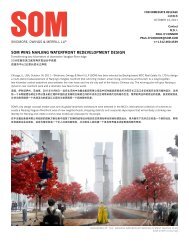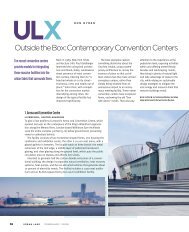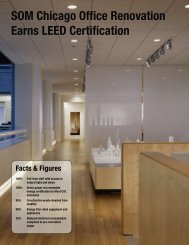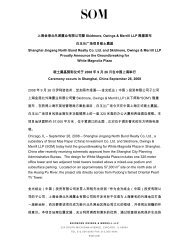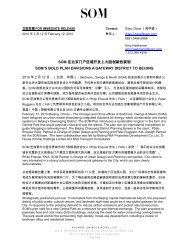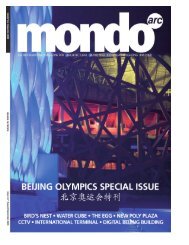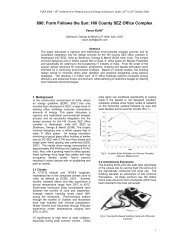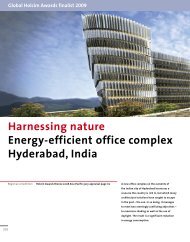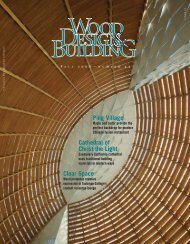THE PERFORMATIVE - Skidmore, Owings & Merrill LLP
THE PERFORMATIVE - Skidmore, Owings & Merrill LLP
THE PERFORMATIVE - Skidmore, Owings & Merrill LLP
You also want an ePaper? Increase the reach of your titles
YUMPU automatically turns print PDFs into web optimized ePapers that Google loves.
<strong>THE</strong> <strong>PERFORMATIVE</strong> WORKPLACE<br />
Healthy Environments, Healthy Employees<br />
A workplace that promotes employee health can contribute<br />
dramatically to an organization’s success by boosting job<br />
performance and cutting health care costs. The same<br />
architectural strategies that promote employee health tend<br />
to be good for the environment: Better mechanical<br />
systems and increased exposure to daylight<br />
lead to healthier environments and healthier<br />
workers—and help the company’s bottom line.<br />
The U.S. Environmental Protection Agency recognizes Sick<br />
Building Syndrome (SBS) as acute discomfort associated<br />
with a building and typically caused by inadequate ventilation<br />
or air contaminants. Studies have found that poor indoor<br />
air quality can diminish productivity by as much as 6-9%.<br />
To solve this problem, use non-toxic finishes, such as paints<br />
that are low in volatile organic compounds (VOCs). To further<br />
boost employee hygiene, some forward-thinking companies are<br />
adopting innovations from the design of healthcare facilities,<br />
such as interior surfaces treated with silver ions to kill harmful<br />
microbes.<br />
Companies can secure public recognition for their environmental<br />
initiatives through Leadership in Energy and Environmental<br />
Design (LEED®) certification. This program, developed by the<br />
U.S. Green Building Council in 1998, now includes a benchmark<br />
specifically for commercial interiors. Using environmentally<br />
sustainable systems and materials often saves money in the<br />
long run, when life cycle costs of materials and building systems<br />
are factored in.<br />
Conclusion<br />
As the design of the workplace comes to be viewed as an<br />
integrated product capable of supporting employee work<br />
patterns, adapting to change, and responding to its environment,<br />
it is taking on greater importance as a tool for increasing<br />
organizational effectiveness. Tuning an office for this level of<br />
performance requires an understanding of how people and<br />
information flow through a contemporary work environment.<br />
Inland Steel is one of the first commercial interior projects in the United States<br />
designed to LEED® Platinum specifications, with an active chilled beam system<br />
to save energy and a green leasing model that eliminates the wastefulness of<br />
interior demolition. The sustainability master plan includes a double glazed<br />
facade, motorized shades, 3 different green material palettes and personal<br />
control of light, sound and air.<br />
5<br />
6<br />
W.J. Fisk and A. H. Rosenfeld, “Estimates of Improved Productivity and Health from Better Indoor Environments” in Indoor Air 7 (1997), 158-172<br />
David Wyon, “The Effects of Indoor Air Quality on Performance and Productivity” in Indoor Air 14 (2004), 100



